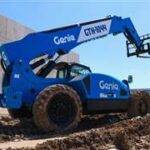1. The Birth of JLG: A Commitment to Safety
In 1969, John L. Grove, the founder of JLG, witnessed a tragic scaffolding accident—a moment that changed everything. At the time, construction workers relied heavily on traditional scaffolding, which posed significant safety risks and led to frequent accidents. Recognizing the urgent need for a safer and more efficient solution, Grove was inspired to develop a revolutionary piece of equipment.
In 1970, he founded JLG Industries, Inc., introducing the world’s first JLG® aerial work platform (AWP). This innovation marked the beginning of the modern aerial access industry, transforming how workers performed tasks at height. Since then, JLG has continued to lead the industry with cutting-edge technology and a relentless commitment to safety.
2. Technological Innovations and Product Development
Since its inception, JLG has consistently pushed the boundaries of aerial work equipment, prioritizing safety, reliability, and efficiency. Here are some key milestones in its product evolution:
-
1970s: The Birth of the Aerial Work Platform
-
JLG introduced its first aerial work platform, revolutionizing the way workers accessed elevated job sites.
-
The hydraulic lifting system provided safer and more flexible height access than traditional scaffolding.
-
-
1980s-1990s: Expansion of the Product Line
-
JLG expanded its product offerings to include telehandlers, catering to various job site demands.
-
In 1991, the company introduced the world’s tallest self-propelled aerial work platform, further cementing its leadership in the industry.
-
-
2000s-2010s: Electrification and Smart Technology
-
In 2006, Oshkosh Corporation acquired JLG, providing additional resources to accelerate innovation.
-
JLG pioneered the use of electric-powered aerial work platforms, reducing carbon emissions and noise pollution.
-
The launch of ClearSky™ telematics allowed real-time monitoring and management of equipment, improving operational efficiency.
-
-
2020s-Present: Automation and Sustainability
-
JLG developed autonomous aerial work platforms, minimizing human operation risks and enhancing work efficiency.
-
Lithium-ion battery technology was integrated into its machines to promote sustainable energy solutions.
-
AI-driven diagnostics and predictive maintenance further optimized equipment performance and longevity.
-
3. JLG’s Global Influence and Industry Leadership
JLG’s innovations have not only shaped the aerial access industry but also established its global presence and influence.
-
Global Reach: JLG products are widely used in construction, maintenance, warehousing, logistics, and energy sectors across the world.
-
Safety Standards: JLG’s advancements have set benchmarks for global aerial work safety regulations, influencing industry guidelines.
-
Training and Support: JLG operates training centers to enhance operator skills and safety awareness while offering worldwide after-sales service.
From the moment John L. Grove witnessed that tragic accident in 1969 to JLG becoming a global leader, the company has remained steadfast in its mission: to make aerial work safer and more efficient. Today, JLG continues to push the boundaries of innovation, leading the industry toward a future of smart, sustainable, and highly efficient aerial access solutions. With its commitment to technology and safety, JLG will undoubtedly remain a key player in shaping the future of aerial work platforms worldwide.





